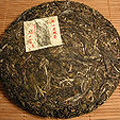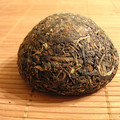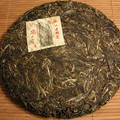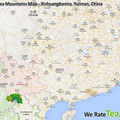Pu-erh tea
„The process used to convert máochá into ripened pu'er is a recent invention that manipulates conditions to approximate the result of the aging process by prolonged bacterial and fungal fermentation in a warm humid environment under controlled conditions, a technique called Wò Dūi (渥堆, "wet piling" in English), which involves piling, dampening, and turning the tea leaves in a manner much akin to composting.“

Quotes Tags: Pu-erh, Shu - Ripe Puerh
- Discussion: 0 comments
- Write a comment
Teas - Pu-erh
2002 Fu Cha Ju Ailaoshan Ripe Puerh Cake
 2 reviews
2 reviewsThis high quality ripe cake is made of spring large-leaf varietal arbor tea from Ailao...
Bulang Shan 2013 - blind tasting set 4
 1 review
1 reviewrich and delicate bulang bitter taste with sweetish aftertaste, sweet tingling almost...
2014 Mengsong Ripe Puerh Cake
 0 reviews
0 reviews2014 late spring harvest, Mengsong area, moderate fermentation. Classic...
2007 Boyou "Man Lu Da Shan" Meng Song
 2 reviews
2 reviewsBoyou tea factory was started by yet another ex-Menghai tea blender. Boyou is well...
2005 Xiaguan Jia Ji Raw Tuocha
 0 reviews
0 reviewsClassic "Jia Ji" recipe! This tuocha is pressed in 2005, composed of 1-2...
2015 Chawangpu Bada Old Tree Xiao Bing
 1 review
1 reviewSince 2012, Bada mountain is one of our personal favorite place and we spend many days...
Quotes - Pu-erh
„This process was first developed in 1972 by Menghai Tea Factory and Kunming Tea Factory] to imitate the flavor and colour of aged raw pu-erh, and was an adaptation of wet storage techniques being used by merchants to falsify the age of their teas. Mass production of ripened pu'er began in 1975. It can be consumed without further aging, though it can also be stored to "air out" some of the less savoury flavors and aromas acquired during fermentation.“

Quotes Tags: Pu-erh, Shu - Ripe Puerh
Video - Pu-erh
Theme
Teas
2009 Menghai "Spring of Menghai" Raw Pu-erh
 1 review
1 reviewThis is a newer Menghai release, first released in 2005 and then again in 2006, 2007, and 2008. This recipe...
Luo Shui Dong 2012 Spring
 1 review
1 reviewThis cake is made from high quality gushu leaves sourced from Luo Shui Dong 落水洞 - a famous puer producing...
2014 Jingmai Gu Shu Huang Pian
 1 review
1 reviewThis tea is from Jingmai Da Zhai, grown in Da Ping Zhang area, and it is considered to be of the finest...
Tea by region
We will help you with tea selection.
Do you like quality loose tea?
We will help you to find the right one for you. Be inspired by tea ratings of other tea lovers. Rating stars could help you.


Review your cup of tea.
Review the tea you are drinking and help other tea lovers to find the right cup of tea.






 Shops
Shops Share on Facebook
Share on Facebook



























